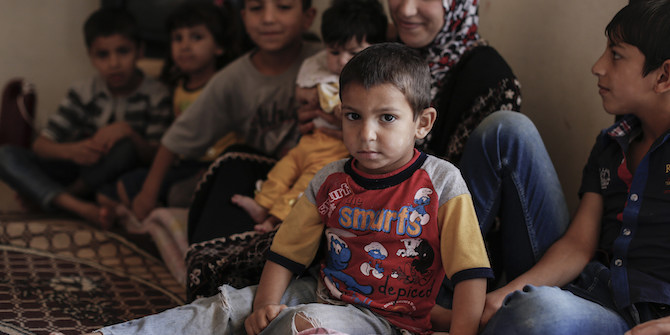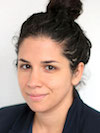by Schadi Semnani

Introduction
In May 2017, an agreement signed by Iran, Russia and Turkey in Astana, Kazakhstan, led to the implementation of a ceasefire and the delineation of de-escalation zones in Syria. The four zones in the agreement are opposition-controlled parts of the southern provinces of Dar’a and Quneitra, pockets around Damascus and Homs, all of Idlib province and western portions of Aleppo province. Over two and a half million people currently live in these areas. Needless to say, if this truce were to hold, it would greatly improve the lives of a large number of people and could prompt a large wave of returnees to these areas. It is against this backdrop that those working in Syria have started to observe an unprecedented wave of returns, both from Turkey, Jordan, Lebanon as well as from IDP camps inside Syria.
Over the past five years, Syria’s displacement figures have been the highest in the region, twice the size of the Iraq figures. Additionally, since the beginning of the armed conflict, Syria’s internal displacement numbers have been in the top three worldwide, both in terms of new displacements and stock numbers (total IDPs at end of year). Stock figures, the total number of people living in displacement at a given time, are especially relevant: for three consecutive years (2013, 2014 and 2015). In terms of new displacements, figures have decreased since 2013, but they are high enough to keep Syria within the top three.
The slight, yet steady decrease in the stock figures may suggest that IDPs are trickling back home, or crossing borders, based on developments on the ground or changes in personal situations. However, a clear picture of returnees – the number, their fate upon return, conditions in places of return, their progress towards achieving durable solutions or alternatively their renewed displacement – is not being systematically captured. Some preliminary data does exist, specifically data collected by the Needs and Population Monitoring (NPM) project of the International Organization for Migration (IOM) and by the Global Protection Cluster, along with data collection being done by some local NGOs.
Needs and Population Monitoring, a project of the International Organization for Migration (IOM) has monitored returnees from January to October 2017 countrywide. They recorded 766,852 returnees in that period, about 40,000 from Turkey, 4,300 from Jordan and 4,500 from Lebanon. Over 700,000 were IDP returns (according to data collected by IOM partners and not publicly available). Surprisingly, according to their data, 96% of returnees reported having returned to their own homes, while only 4% have reported being displaced again upon return.
Population Monitoring Initiative (PMI), an initiative lead by UNHCR and the protection cluster in Jordan, have also been monitoring returns to Syria’s southern governorates. Based on their data, about 2,520 families have returned in the southern governorates (84% of returnees were to Dar’a city and Neimeh town) during the month of September alone. One local NGO in the south has also collected some initial data on returnees to southern governorates this year. They collect their data by speaking to local town councils, where returnees register to receive aid. As of October 2017, they had recorded over 4,000 returns in Dar’a province, more than half of them from inside the province, and about 800 individuals from Jordan (Data collected by local NGO, AFAK, data not publicly available). Similarly to the data collected by PMI, half of the returns recorded were specifically to Dar’a city while another 1000 were to Neimeh, two previously very active frontlines (Data collected by local NGO, AFAK, data not publicly available).
Given the context of the ongoing war in Syria and the polices of the governments of Turkey and Jordan which do not allow returnees to seek refuge in their countries again in the near future, it is difficult to imagine what factors are contributing to the refugees’ and IDPs’ decision to return. In the absence of interoperable datasets along the displacement continuum – internal displacement to refugees to returnees/internal displacement again – this paper aims to shed some light on the push and pull factors throughout the displacement journey and on the wide spectrum of returning refugee and IDP experiences.
Methodological Note
At the end of October 2017, 11 key informant interviews were carried out with individuals residing in Turkey, in Jordan and inside Syria. Six individuals’ stories are profiled in the full paper. Recognising that the size of the sample does not allow for broad conclusions to be reached, this paper aims to provide only anecdotal evidence to begin discussing the phenomenon of returns to Syria. To compliment information gathered from interviews, IDMC data, and reports from UN agencies and news sources were also used for this report.
Conclusion
To demonstrate the complexity of displacement trajectories of IDPs and refugees, and the decision-making process that goes with each move, six cases are detailed in the full paper. Despite the difference circumstances facing people returning to the provinces of Idlib, Aleppo and Dar’a, a few overarching push and pull factors were identified in all case studies. These factors include:
- Economic pressure in places of displacement, whether in Turkey, Jordan or Syria was the top factor in the decision-making process;
- Feelings of alienation and discrimination in places of displacement also figured heavily in the decision making process;
- The improvement in the security situation has definitely been a factor in making people feel they are able to take their families back home, and has, at times, been the trigger for that decision, but it has not been the underlying reason for return;
- Presence or lack of basic services have not played a big role in the decision of returnees. The status of basic services in most of the areas of returns are still very poor but this has not deterred returnees;
- Family ties, which almost always play a role in deciding a family’s next move. When family ties do not exist in other villages or abroad, the decision to move and where to go is ever more difficult.
This is an abridged version of a paper given at a conference on Responses to Displacement in the Middle East, held at the LSE on 30 November 2017. See below for the full list of papers.
 Schadi Semnani is a researcher at the Internal Displacement Monitoring Centre, where she leads the Policy and Research team’s country research portfolio, including the further development of IDMC’s country pages and building local research networks, the IDUs and GRID country analysis and spotlights. She tweets at @ssschadi
Schadi Semnani is a researcher at the Internal Displacement Monitoring Centre, where she leads the Policy and Research team’s country research portfolio, including the further development of IDMC’s country pages and building local research networks, the IDUs and GRID country analysis and spotlights. She tweets at @ssschadi
In this series:
- Introduction by Zeynep Kaya
- The Politics of Return in post-ISIS Iraq by Kyra Luchtenberg
- Going Back or Staying Better: Processes of Return After Displacement due to ISIL by Nesreen Barwari
- Breaking the Vicious Circle: Exploring Alternatives to Current Responses and Solutions to Internal Displacement in Yemen by Stean Auguste Tshiband
- Iraq after the Islamic State: Displacement, migration and return by Irene Constantini
- Displaced and on the Move Again: Decision-making among IDPs who migrate to Europe by Megan Passey
- Violence, Insecurity and the (Un)making of Rukban Camp by Suraina Pasha
- Between International Influence and Domestic Politics: The case of the refugee control policy towards Syrian refugees in Lebanon by Zad El Hage Sleiman
- Fleeing Home at Home: Internal Displacement in Homs, Syria by Ammar Azzouz and Irit Katz
- A Phenomenological Exploration of the Gendered Vulnerabilities of Internally Displaced Syrians by Jaclynn Robinson
- Chaos and Fear: Governmental strategies to hinder national and international humanitarian responses to internal displacement in Turkey by Eva Jones
- Administrative Violence and Palestinian Displacement in West Bank Area C by Mustafa Fatih Yavuz
- Local Integration in the Context of Protracted Displacement Inside Syria by Simon Verduijn






